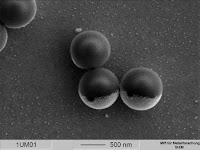Dilution-Induced Aggregation of Nanoparticles
The ability of nanoparticles to self-assemble forming larger structures is determined by the details of the forces between particles. This mean of interaction has led to novel concepts in self-assembly such as in colloids and Janus particles (type of nanoparticles with two or more physical properties of its surface). Recently, some models that include attractive region or 'patches' on the surface of nanoparticles have been made and predict intricate modes of assembly and these interactions are also important in a range of phenomena including protein aggregation and crystallisation.
Meijer's group Eindhoven University of Technology successfully synthesised 6-nm nanoparticles with dynamic hydrophobic patches and it can self-assemble reversibly in water.
The system in this nanoparticles is the fifth generation of urea-adamantyl terminated polypropylene imine) dendrimer as the host molecule for acetic acid moiety.
The acetic acid moiety binds to the host molecule via acid-base interaction with the tertiary amine of the host molecule and the stability of this interaction is enhanced by multiple hydrogen bonding interactions of host-host and host-guest interactions. In this system, the host molecule cannot be dissolved in water directly as the hydrophobic forces between the bare host molecule is too strong even in the presence of guest molecule. However, a guest-host pre-complex can be made in chloroform then transferred into water through the neat state such as thin film.
By comparing 2D and 3D images, it shows that the spherical object originates from worm-like structures viewed head-on with radius corresponding remarkably well with single dendrimer surrounded by guest molecules.
 |
| Example of Janus particles (accessed http://www.pi2.uni-stuttgart.de/cms/index.php?article_id=156) |
The system in this nanoparticles is the fifth generation of urea-adamantyl terminated polypropylene imine) dendrimer as the host molecule for acetic acid moiety.
 |
| Fifth-generation urea-adamantyl poly(propylene imine) dendrimer (host) and the ureido acetic acid guest molecule (guest) and its complex. |
From the stepwise synthesis, the results of the formed nanoparticles are greatly dependent on the host-to-guest ratio used. If the number of guest molecules n per host molecule is low compared with the number of binding sites B of the host molecule (n/B < 1), a kinetically trapped structure, 'trapped core particle' is formed. In this case, the number of guest molecules is not sufficient enough to cover all the hydrophobic surface, so strong hydrophobic interactions between these particles can happen via those hydrophobic patches.
 |
| Formation of aggregates |
On the other hand, when the number of guest molecules is higher than number of binding sites, n/B > 1, the binding sites are fully occupied by the guest molecule resulting 'patchy particles'. Interestingly, upon dilution of these particles, change of structure was observed; structural changes was not observed in the first case. The change of structure as the patchy particles were diluted can be explained as the number of bound guest molecules on concentration according Langmuir adsorption isotherm. Hence, upon dilution the hydrophobic patches are uncovered resulting irreversible aggregation forming dimers, trimers, and so on.
The structures present in solution at different concentration were visualised by cryo-transmission electron microscopy (cryoTEM) and it showed the coexistence of spherical and worm-like object. However, cryoTEM performed at 24.6 mM solution showed a highly branched network with a high density of y-type junctions.
CryoTEM images at 24.6 mM
By comparing 2D and 3D images, it shows that the spherical object originates from worm-like structures viewed head-on with radius corresponding remarkably well with single dendrimer surrounded by guest molecules.
This study shows the reversible nature of the patches due to fast guest-host binding dynamics which can be used to control the number on average present at the surface. This implies the effective valency of the particles can be tuned to form the network of this particles. Besides that, the aggregation of the particles counter-intuitively happens upon dilution and regulated by adsorption equilibrium. Furthermore, this study set as an example of a multi-component supramolecular system with multiple interacting equilibria and could help close the gap between complex biological and colloidal-like system.
Reference
T. M. Hermans, M. A. C. Broeren, N. Gomopoulos, P. van der Schoot, M. H. P. van Genderen, N. A. J. M. Sommerdijk, G. Fytas, and E. W. Meijer, Nature Technology, 2009, 4, 721-726.
Reference
T. M. Hermans, M. A. C. Broeren, N. Gomopoulos, P. van der Schoot, M. H. P. van Genderen, N. A. J. M. Sommerdijk, G. Fytas, and E. W. Meijer, Nature Technology, 2009, 4, 721-726.
Comments